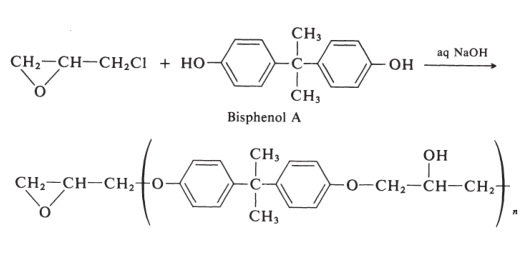Resin epoxy
Synonym(s):Epichlorohydrin homopolymer;Epoxychloropropane homopolymer;Poly[(chloromethyl)ethylene oxide]
- CAS NO.:24969-06-0
- Empirical Formula: C3H5ClO
- Molecular Weight: 92.52
- MDL number: MFCD00084412
- EINECS: 607-468-0
- SAFETY DATA SHEET (SDS)
- Update Date: 2025-01-27 09:38:02

What is Resin epoxy?
Description
Resin based on epichlorohydrin and bis phenol A. Oligomers may vary in molecular weight from 340 and higher. May produce erythema multiforme like eruptions. The higher the molecular weight, the less sensitizing the compound.
Chemical properties
Resin epoxy is white to straw slab
The Uses of Resin epoxy
Resin epoxy is Surface coatings, as on household appliances and gas storage vessels; adhesive for composites and for metals, glass, and ceramics; casting metalforming tools and dies; encapsulation of electrical parts; filament-wound pipe and pressure vessels; floor surf
The Uses of Resin epoxy
Epoxy resin is used in adhesives, surface coatings, electrical insulation, plasticizers, polymer stabilizers, laminates, surface coatings, paints and inks, product finishers, PVC products, vinyl gloves, etc.; in the building industry, electron microscopy, and sculpture.
Definition
Resin epoxy is a thermosetting resin based on the reactivity of the epoxide group. One type is made from epichlorohydrin and bisphenol A. Aliphatic polyols such as glycerol may be used instead of the aromatic bisphenol A. Molecules of this type have glycidyl ether struc
Preparation
Epoxy resin is prepared by the following condensation reaction:

The condensation leaves epoxy end groups that are then reacted in a separate step with nucleophilic compounds (alcohols, acids, or amines). For use as an adhesive, the epoxy resin and the curing resin (usually an aliphatic polyamine) are packaged separately and mixed together immediately before use.
Epoxy novolac resins are produced by glycidation of the low-molecular-weight reaction products of phenol (or cresol) with formaldehyde. Highly cross-linked systems are formed that have superior performance at elevated temperatures.
Hazard
Strong skin irritant in uncured state.
Properties of Resin epoxy
| Melting point: | 115-120 °C |
| Density | 1.36 g/mL at 25 °C(lit.) |
| Flash point: | 252 °C |
| form | slab/chunk |
| Dielectric constant | 2.5(Ambient) |
| EPA Substance Registry System | Oxirane, (chloromethyl)-, homopolymer (24969-06-0) |
Safety information for Resin epoxy
Computed Descriptors for Resin epoxy
New Products
(R)-1-Boc-3-hydroxypyrrolidine Methyl (R)-1-Boc-4,4-difluoropyrrolidine-2-carboxylate 2,2-Difluoropropylamine hydrochloride tert-butyl 3-bromoazetidine-1-carboxylate DIFLUOROACETIC ANHYDRIDE 2,2-Difluoropropionic acid Diallylamine, 99% Calcium hydroxide, 95% Aluminum oxide, basic 2-Bromophenylacetonitrile, 97% L-tert-Leucine,97% N-Hydroxy-2-methylpropanimidamide 4-(3,4-Dichlorophenyl)-3,4-Dihydro-N-Methyl-1-(2H)-Naphthalenimine (Schiff Base) 2-AMINO-3,5-DIBROMO BENZALDEHYDE [ADBA] L-Glutamic Acid Dimethyl Ester Hcl 10-Methoxy-5H-dibenz[b,f]azepine 5-Cyanophthalide N, N-Carbonyldiimidazole (CDI) Dibenzoyl Peroxide Titanium Dioxide 2-(Methylthio) Benzonitrile Sodium Acetate Anhydrous Allopurinol 1,5-DibromopentaneRelated products of tetrahydrofuran








You may like
-
 24969-06-0 EPOXY RESIN 98%View Details
24969-06-0 EPOXY RESIN 98%View Details
24969-06-0 -
![Cis-2-(Bromomethyl)-2-(2,4-Dichlorophenyl)-1,3-Dioxolane-4-Ylmethyl Benzoate [CBB] 61397-56-6 99%](https://img.chemicalbook.in//Content/image/CP5.jpg) Cis-2-(Bromomethyl)-2-(2,4-Dichlorophenyl)-1,3-Dioxolane-4-Ylmethyl Benzoate [CBB] 61397-56-6 99%View Details
Cis-2-(Bromomethyl)-2-(2,4-Dichlorophenyl)-1,3-Dioxolane-4-Ylmethyl Benzoate [CBB] 61397-56-6 99%View Details
61397-56-6 -
 287930-77-2 / 142569-70-8 99%View Details
287930-77-2 / 142569-70-8 99%View Details
287930-77-2 / 142569-70-8 -
 Ethyl-2-Chloroacetoacetate 609-15-4View Details
Ethyl-2-Chloroacetoacetate 609-15-4View Details
609-15-4 -
 CIS- BROMO BENZOATEView Details
CIS- BROMO BENZOATEView Details
61397-56-6 -
 609-15-4View Details
609-15-4View Details
609-15-4 -
![1-(6-Methylpyridin-3-Yl)-2-[4-(Methylsulfonyl)Phenyl]Ethanone [Ketosulfone] 99%](https://img.chemicalbook.in//Content/image/CP5.jpg) 1-(6-Methylpyridin-3-Yl)-2-[4-(Methylsulfonyl)Phenyl]Ethanone [Ketosulfone] 99%View Details
1-(6-Methylpyridin-3-Yl)-2-[4-(Methylsulfonyl)Phenyl]Ethanone [Ketosulfone] 99%View Details
221615-75-4 -
 27143-07-3View Details
27143-07-3View Details
27143-07-3
